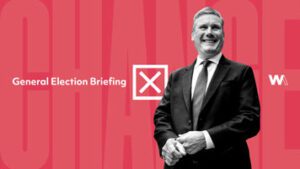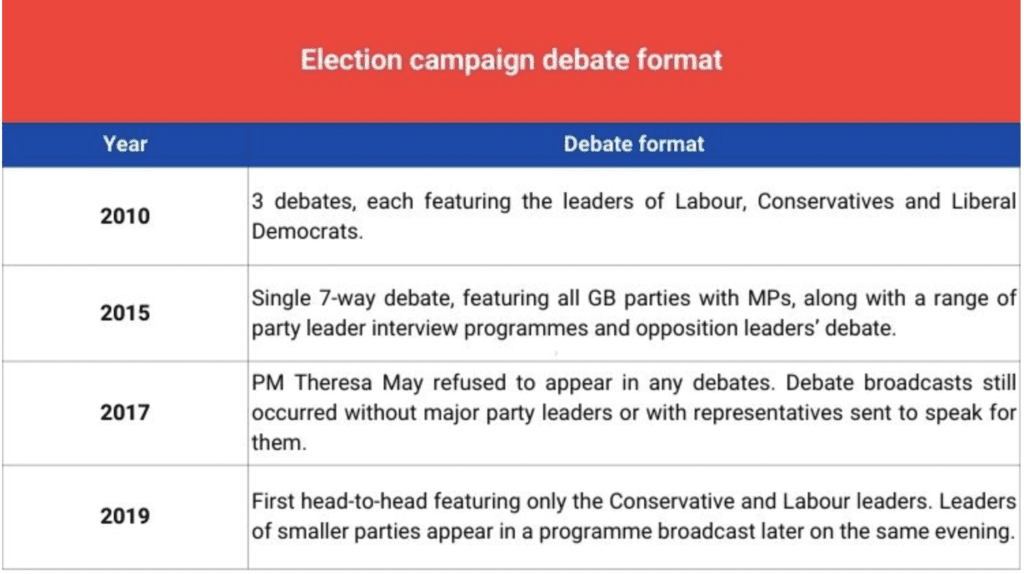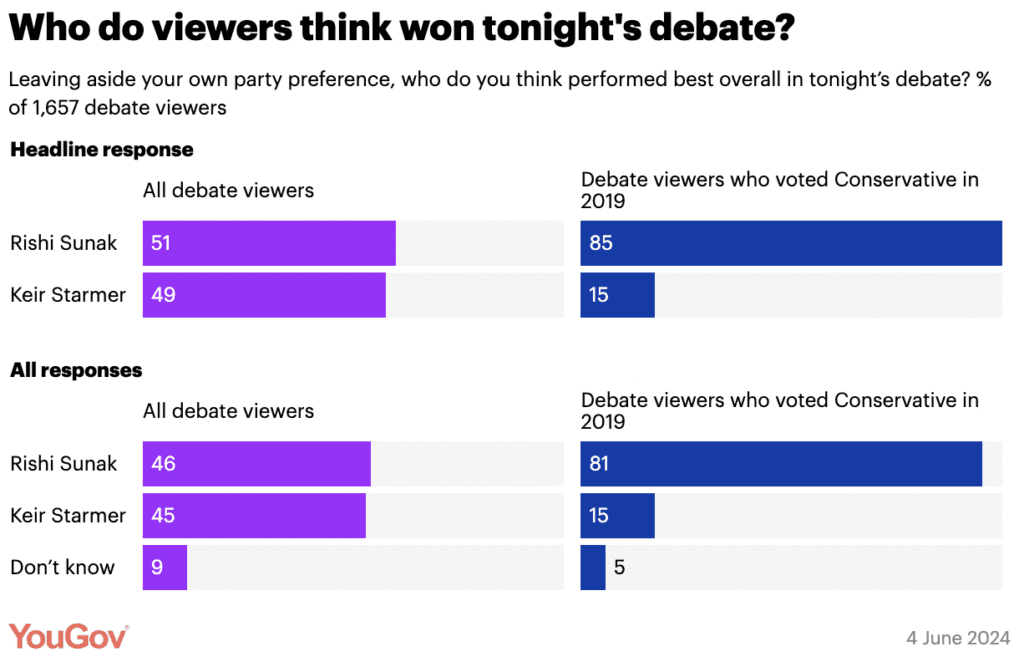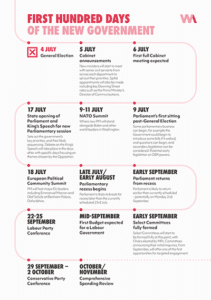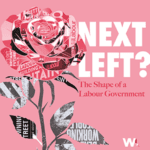From the Labour Party’s ‘slow and steady’ approach and a relentless focus from the Lib Dems, to the potential decline in Scottish Nationalism and a battle for the soul of the Conservative Party – the general election campaign sees changing party strategies as well as the possibility of change for the country.
The Conservative Party
Has Rishi Sunak fired the starting gun for a general election or the battle in the fight for the soul of the Conservative Party? As the Party machinery goes into campaigning mode, it is worth considering Sunak’s chance.
But first, how did we get here? For Sunak, the logic is clear. The polls haven’t shifted despite his best efforts and Sunak has decided to pull the general election lever to change his political fortunes. Holding out until November and being perceived by the electorate as vainly waiting for any kind of good news would’ve risked fueling the sitting duck narrative.
Never say never: Three measures of success for Sunak’s campaign
Febrile election campaigns can throw up any kind of outcome contrary to conventional wisdom. A measure of Sunak’s campaigning success will be a seismic shift of the political narrative and public opinion to narrow-in on Starmer’s average 17-point lead, bringing it down to a margin of uncertainty sufficient for a possible rabbit out the hat type moment.
A second measure of success for Sunak’s campaign will be the movements of Tory big beasts and possible leadership successors. Will the chief Conservative campaigner of the 21st century, Boris Johnson, put aside the et tu, Brute maneuverer of his former Chancellor and make a return to pounding the streets for the sake of the Party?
It’ll be worth keeping an eye out for Sunak’s successor hopefuls, such as Robert Jenrick or Suella Braverman, who will likely sit this one out. The only rationale for a successor hopeful to softly side with Sunak in this campaign is positioning as a future party unity candidate.
A third measure of success will be neutralising the Reform risk. Expect restoring the economy and the security of the UK in a more uncertain world to be the meta-framing of Sunak’s electoral pitch.
The National Service and “Triple Lock Plus” for pensioners reflects a survival campaign tactic of appealing to your base. Why? Because while Farage will not be standing for a seat, Reform UK risks outflanking the Tories from the right. Even some longstanding, loyal Conservative voters might even be asking, does my party really deserve to win again?
The Labour Party
If the Prime Minister was hopeful that Labour would be taken off-guard by his surprise announcement of the general election last Wednesday, he has surely been disappointed. Having pushed the party machine to prepare for an election from May onwards, Starmer and his campaign chief Morgan McSweeney have made a point of being prepared.
With vetted candidates in place across most winnable seats and a messaging strategy and manifesto agreed, Labour has managed to smoothly transition into campaign mode ahead of the dissolution of Parliament. Indeed, while the Prime Minister was still drying off from his speech on the steps of Downing Street, Starmer’s team launched a slick campaign video announcing the party’s election slogan: simply, ‘Change.’
Going forward, we expect Starmer’s team to take a ‘slow and steady’ approach, taking few if any risks – a strategy which makes sense if you are defending a 20-point-plus poll lead. However, it would be a mistake to read too much into Starmer’s middle-of-the-road campaigning style. Far from representing a rehash of Blairism, the contours of a distinct Starmerite project are becoming clear.
The thesis shared by Starmer and his Shadow Chancellor, Rachel Reeves, is that the UK is vulnerable – to international threats and domestic political upheaval – due to a public sense of insecurity. In their view, this multipronged insecurity caused the Brexit vote, Boris Johnson’s landslide win in 2019, the cost-of-living crisis, and it is feeding the growth of Nigel Farage’s Reform UK.
On a domestic level, their solution to insecurity is Rachel Reeves’ ‘securonomics’: a more active state using industrial policy, planning reform, and insourcing to stimulate growth, with proceeds reinvested in priorities like public services and defense. On the international stage, these policies will be supported by Shadow Foreign Secretary David Lammy’s ‘progressive realism’ which aims to secure UK supply chains while rebuilding ties in Europe.
Politically, this technocratic project is being communicated with the language and imagery of communitarianism – the slogan ‘country first, party second’, the use of the Union flag on party literature, and a hard line on crime and defense.
Despite its consistent poll leads and a drama-free first week of the campaign, Labour remains nervous. The party is used to losing, having spent the last 14 years in the wilderness, and McSweeney’s team is determined to root out complacency.
Even if they succeed and enter Downing Street, there is a list of simmering crises that could throw an incoming Labour government off track. These include global issues like the war in Ukraine, the Middle East conflict, and the potential return of Donald Trump. But they also include UK-specific issues, like sluggish economic growth and the financial precarity of universities and local councils – many of which are expected to go bust.
Starmer’s chief of staff, Sue Gray, is said to be actively planning for these eventualities to ensure the party is ready to react quickly. But even the best laid plans can collapse on contact with reality. Any one of these issues alone could cause a major headache for an incoming Labour government. Together, they could destroy the Starmer project before it has even got started.
The Liberal Democrats
The Liberal Democrat’s strategy this General Election is relatively easy to understand: relentlessly focus on the 70-90 seats where they are clearly the best placed party to defeat the Conservatives, and largely ignore the rest of the country. They are no longer positioning themselves as equidistant between the two larger parties – they are unashamedly anti-Tory, setting themselves up as the only people who can defeat the Conservatives in certain parts of the country.
This hyper-localised and focused approach will focus on two different types of seat.
Firstly, large swathes of what has become known as the ‘Blue Wall’: largely in the South East as well as a handful of seats in the north with similar characteristics. These areas have seen demographic change in recent years with younger families moving out from London, have higher than average proportions of ‘Remain’ voters, and a population with more ‘liberal’ values. The fact that the Prime Minister visited four key Lib Dem target seats across South West London, Buckinghamshire and Hertfordshire this weekend shows the impact this strategy is having.
Secondly, those parts of the UK where the party has traditional strength, particularly the South West.
As always within the Liberal Democrat party, some excited activists see an opportunity to secure upwards of 70 seats. More seasoned hands in the party see 40-50 seats as success. Unlike 2019, there is a laser-focus on targeting resources at those seats that are genuinely winnable.
In terms of campaign themes, Brexit is largely off the table, with the focus being on the environment and the quality of public services, particularly care. However, the level of policy detail sitting behind these issues is very limited. Were the party to play a more significant role in the next parliament their level of policy thinking – and the input from businesses into this – will need to mature significantly, quickly.
The Manifesto – and other policy announcements throughout the campaign – will focus on these themes and issues that will be seen to resonate with target voters in these key seats. Expect a small number of impactful policies – tougher water regulation, improved access to GPs, and new resources for the care sector.
Scotland
Labour, the SNP and the battle over the border
Scotland remains pivotal in determining which party forms the next UK Government. The overall General Election contest will be defined by the resurgence of Labour in the region – but does the Scottish National Party (SNP) still stand in the way?
The SNP has dominated Scottish polls for the last decade or so, but the Party faces significant challenges as it enters this campaign period.
While the SNP secured 45% of the vote and 48 of Scotland’s 59 seats in the 2019 General Election, recent Ipsos polling indicates a more negative outlook for 2024, with strong public dissatisfaction over living standards. Notably, and potentially damaging in the long term, independence — once a defining feature of the SNP — has fallen to fifth place on the list of priorities for Scots. It now finds itself trailing behind the NHS, cost of living, education, and the wider economy.
Thrown in at the deep end, the newly elected First Minister John Swinney hopes to rescue the Party from growing dissatisfaction amongst voters, a loss of donors and public skepticism off the back of recent policy failures and police investigations.
Working to put these hurdles behind him, Swinney’s campaign “Put Scotland First,” aims to re-engage voters by focusing on uniting Scottish people and bringing independence back to the forefront of SNP ambition.
In the meantime, capitalising on growing SNP discontent and working to reinstate the credibility of Scottish Labour alongside the popular Anas Sarwar, Labour leader Sir Keir Starmer has placed Scotland at the centre of his campaign, stressing its importance for national renewal. “There’s no Labour without Scotland”, the two leaders stated at the Party’s campaign launch in Glasgow last week.
Whilst Scottish votes are unlikely to solely determine the next ruling party in Westminster, with 57 seats up for grabs, the voting sway of Scots could significantly impact the extent of Labour’s victory. Recent polling indicates a remarkable red resurgence, suggesting they could win over 30 seats, while the SNP’s representation could drop to the low teens.
This contest is crucial, and one to watch closely. The outcome will depend on the degree to which the SNP can regain the trust of the Scots, how far Starmer is committed to visiting the region, and to what extent he, and Anas Sarwar, can truly make voters believe that Scotland will be a centerpiece of a future Labour government.
